| Previous |
Next |
Talofa (Hello)
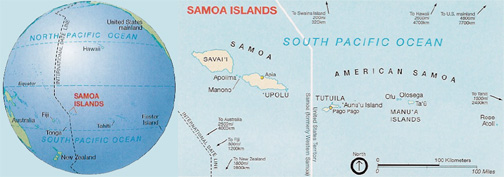
This is the eastern half of the Samoan archipelago. The native language, food, and customs of the people of American Samoa are almost identical to her western sister.
Q: What is different about American Samoa (AS) in geography, geology, and history?
A: There are seven islands in AS and some coral atolls. The islands are volcanic like Western Samoa. The main island, Tutuila has steep jungle covered mountains, many with permanent waterfalls. One large mountain, called the Rainmaker, keeps the wetter weather on one side of the island, and drier weather on the other. There is a high plateau to the south but agriculture other than basic tree crops (like coconuts and bananas) and root crops like taro is not common due to the sloping terrain.
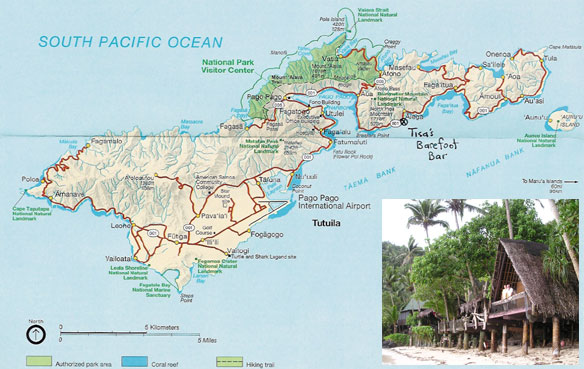
The capital is Pago Pago (pronounced Pango Pango) and lies on a harbor that is deep and cuts way into the island. Standing at the water there, you are almost surrounded by mountains giving you the feeling you are in a fiord. It is this deep-water harbor that changed AS's history. The Polynesians settled here about 1000 BC. As elsewhere in the South Pacific, European explorers and missionaries came, bringing conservative and religious changes to the culture. In 1870, American businessmen saw Pago Pago as an ideal place to refuel their coal-burning ships traveling between Australia and San Francisco. The U.S. Navy negotiated a treaty with the Samoan chiefs in 1872 but it was not until World War II and afterward that the American influence took hold. Thousands of Marines were trained in Tutuila, some now retired here. AS was then virtually ignored (what the U.N. called "benign neglect") until 1961 when JFK had the U.S. government dispense millions of dollars for roads, schools, housing, electricity, a tuna cannery, and other projects. This has created a standard of living in AS that is still dependent on U.S. funds, both direct and through food stamps.
AS is presently an unincorporated territory of the U.S., so our Constitution and some laws do not apply. Most Samoans do not want to be under the Constitution as it would end the village structure and local justice system (see below). AS does have a non-voting member in our House of Representatives, an elected governor, and their own local "congress" called the Fono with senators chosen by the village chiefs and elected representatives. AS also does not want to be independent, as it would end the U.S. government handouts. AS people can become U.S. citizens, but they are not born as such. They pay the same levels of Federal Income Tax as we do, but all the tax money remains in AS.
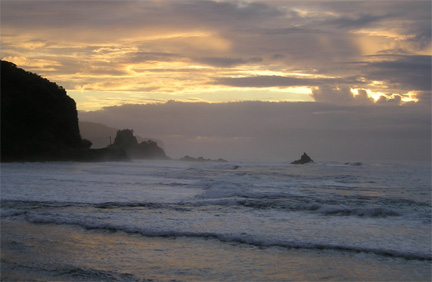
Q: What is American about American Samoa? And what is not?
A: As you leave the airport, you are greeted by a McDonalds/PizzaHut/KFC complex, not the best of American culture. Most people speak English and most signage is bilingual (Samoan/English). The teenagers here dress and talk like their American counterparts. The island is decorated with red or blue banners celebrating the upcoming big high school football game (Warriors vs. Vikings).
The currency is the U.S. dollar and the U.S. Postal Service handles the mail. The newspaper covers U.S. mainland news as well as what is happening elsewhere in the South Pacific. Many items on a restaurant menu or on a store shelf would look familiar to you. However, we could not find a store that sold deodorant, whatever that means.
Music is a mixture of Samoan melodies accompanied by ukulele and guitar, American music, and "Sweet Home Samoa" (music just like "Sweet Home Alabama" with different words). We suspect some of the songs have violated copyrights, but who would be listening to Samoan radio to find out? They have started playing Christmas music here. Our least favorite is the Samoan version of "Little Drummer Boy". Sung slower than normal by a guy (we think) with a marginal voice, it also has some verses repeated and no drum accompaniment. Di thinks it holds the world's record for longest Christmas song.
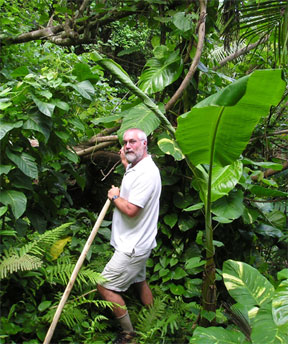
Weather is somewhat like coastal Florida in the summer. It is hot, humid, with sea spray in the air. As a result, everything rusts quickly. This includes metal roofs, cars, outdoor pipes, and metal furniture. People spend a lot of time out on their one-piece green or white plastic chairs. In fact, we see these everywhere we go. The island contains two huge tuna canneries (one is Sunkist) so when the wind is right (or wrong), the fish smell permeates one area of the harbor. We are reminded of the paper mill smell in Muskegon, but this is much stronger. By the way, these canneries are not covered by minimum wage laws so the top hourly pay for their workers is under $3.50. No unions here.
As in Western Samoa, the men wear the lava-lava skirts. We could not figure out why there were so few women's clothes in the stores and why so many fabrics are available. Here, most the women's clothing is custom made by one of the dozens of seamstresses around the island. This would include their daily housedresses as well as two piece (skirt and top) suits with lovely appliqués and detailing. I still do not know how the ladies can wear these form-fitting outfits all day and look fresh as a daisy. Within ten minutes of a cold shower, Di looks as wilted as a week-old bouquet!
You would not want to be a realtor in AS as 90% of the land is family owned and is never sold. Burial of landowners in the front yard emphasizes that fact. As in Western Samoa, a group of extended families makes up a village, ruled by a chief. Although there is a police department and courthouse, most justice is imparted through the village system. If a village member is arrested by the police for being drunk, for example, the village chief may punish that person by ordering him and his family to provide a huge meal for the entire village. Pressure by the family would certainly lower the chance of that person being caught drunk again!
AS has only about 9,000 tourists a year (Tahiti gets 20 times that). This is because there are few flights here and limited accommodations. As two of the few palangi (whites) here, we stood out in certain places. However, the people were always helpful. The Samoans we talked to would welcome an increase in visitors to their lovely islands.
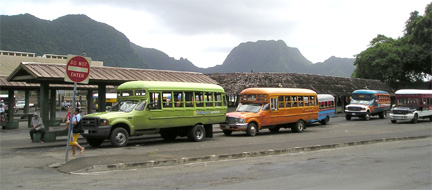
Q: How did you get around?
A: We stayed about seven miles from Pago Pago, so we took the local buses everywhere. The fares range from 25 cents to $1.50, paid when you get off. You can get picked up/dropped off anywhere. It was common to have the bus drop someone off, then stop about 100 feet later to drop off someone else (talk about home delivery). The buses are built of wood onto the frame of pickups so the driver sits very low compared to the passengers. There are sheets of plexiglas you can pull up as windows if it rains. The bus driver can customize his bus with flashing lights inside, very loud music systems playing Samoan rap, and some wild paint jobs to match the bus name. For example, the Casper bus has the "friendly ghost" on the side; the Titanic bus has a sinking ship, etc. The actual route name for the bus is usually a hand-drawn sign in the bus window (if there is a sign at all). The locals know what bus to take. We, on the other hand, waited 90 minutes for a bus to the National Park that never came. Plan B was to see the island by getting on a bus and riding it to the end of its route and back. Cheapest tour we have taken. Students ride for 25 cents and we often saw kids with a quarter wedged into their ear, as they had no pockets!
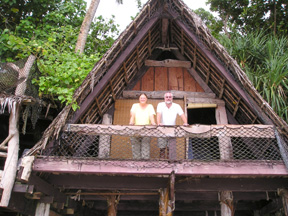
Q: Where did you stay?
A: There are actually very few budget places to stay in AS and no hostels. The guidebooks all recommended Tisa's Barefoot Bar, an open-air beachside bar with several multilevel decks. Tisa's has two fales (traditional island bedrooms, pronounced fal-lay) for people to stay. However, our fale was more than beachside. It was a large hand built bedroom and deck cantilevered over the ocean so at high tide, the waves flowed under us (see attachment). We used the bar toilet. The shower opened out into the ocean with a pvc pipe that delivered unheated mountain stream water. Yes, it was a cold shower but after the hot Samoan weather, it really was welcome.
Our hosts were quite a pair of characters. Tisa is a Samoan firebrand. She is one of the rare independent Samoan women (with her father's blessing). She has run for governor, is active in community affairs and is committed to maintaining Samoan culture. Her partner is Candyman, a former New Zealander who has assimilated into Samoan life. He has a traditional tattoo (completely covered waist to knees), always wears a lava-lava (even when swimming), speaks Samoan, and works very hard to improve conditions in Tisa's nearby village. He built the bar, decks, and fale from found and recycled materials. And he is always in bare feet.
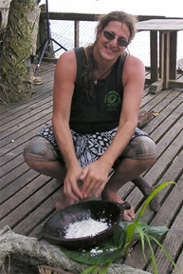
Q: What did you eat?
A: Both Tisa and Candyman are excellent cooks. Our meals included cici (a local shellfish), fish curry, NZ steaks, Alaskan crab omelets, huevos rancheros (eggs Mexican style), and a traditional umu. Some umus would involve burying a whole hog in a pit. However, Candyman has customized the process. Cooking with an umu is quite involved. First, a fire is made of wood and coconut shells/fibers topped in rocks. When the rocks are very hot, all wood is removed. Then the layering begins. At the bottom are hot rocks covered with strips of fresh banana tree wood. The wood holds lots of moisture, which produces steam to cook the food without burning it. Then the food is packed between the rocks, coconut meat (with the cream squeezed out) is sprinkled on, more hot rocks added on top and the pile is covered with large leaves to seal in the heat and steam. Included in the food pile was a turkey, pork butt, NZ lamb, half coconut shells filled with coconut cream/young taro leaves or coconut cream/fish, bananas, breadfruit, and papaya with cinnamon. After three hours, the food is uncovered and spread on a long table, with clean big leaves as the tablecloth. Other guests had arrived by then and the whole group of us ate the smoky, delicious blend of flavors with our fingers until we were stuffed. For entertainment, we watched Tisa's two young granddaughters perform traditional dances. We were fortunate to be able to watch Candyman and his assistant do the whole process. I do not think we will try this at home.
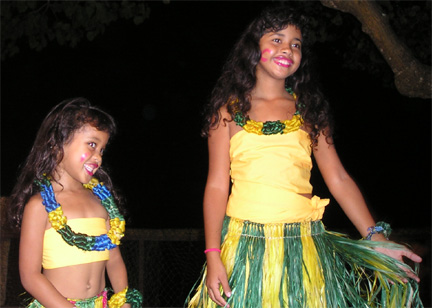
Q: What did you do there?
A: The bay on which Tisa's sits is a marine reserve set up by the village. The mountain stream nearby has emptied into the bay for centuries, cutting a crevice 45 feet deep into the coral and rock in the seawater. Candyman took us snorkeling twice here. You could see lots of fish (including a reef shark) deep down in the crevice where the fresh and seawater meet. The current was strong so we were happy to have a guide.
He also took us up to the "backyard", a plantation on the mountainside. We climbed the slippery narrow trail (us in boots, Candyman barefoot) cut through the thick growth. Here he has replanted parts of a neglected plantation with coconut, taro, bananas and traditional food/medicinal plants that have become rare in Samoa. We saw several different types of bananas and taro, the tree whose bark is used to make the real grass skirts, and a vine that is planted to keep away ghosts, among others. His goal is to restore the plantation not only with food plants to be used now, but with plants that can be eaten in case of a hurricane. For example, one plant has a root that spreads widely and is edible even if the plant itself is destroyed. An interesting fact is that if a storm is coming, it is better to chop all the leaves off the banana trees, including fruit. A leafless tree will survive the wind and quickly produce bananas while a leafed tree is likely to blow over. Candyman's plans for this plantation and using the mountain streams to generate electricity were impressive. We were very lucky to have this personal tour and are thankful for his thoughtful answers to all our questions.
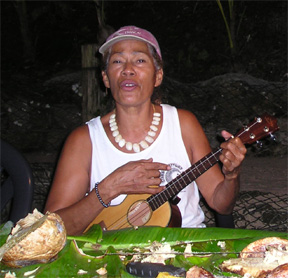
While we were in AS, they had the election for local offices and their U.S. Congress Representative. Tisa was working on getting women elected (a rare occurrence here). Her stories of the electoral process had us laughing. Unfortunately, the antics of politicians seem to be universal. For example, one man was re-elected even though he was under arrest in Hawaii for fraud. Another (also re-elected) spent the few days before the election giving $5 handshakes to potential voters. On election day, each political party set up tents near every polling place. Here they cooked and distributed barbequed chicken dinners to supporters as they came to vote. As we traveled the island on the bus, we could tell where the polling places were by smell of chicken. In the last election, there were some people who voted as both American and Western Samoans (illegal). So it was not surprising to see a political ad that stated, "Please vote for me the first and only time you vote".
We did not know what to expect in American Samoa. The guidebooks were somewhat neutral. Needless to say, the American Samoa experience was far more than we had hoped. For those of our MCC colleagues wishing to escape the Michigan winter, there are faculty openings in English, Sociology/Psychology, and Business/Accounting at Samoa Community College.
Heading now for the Kingdom of Tonga. Keep safe and healthy. Fa'afetai (thanks) for reading and Tofa (goodbye).
Di & Tim
| Page Top |
Map |
Itinerary |
Previous |
Next |
| Tim and Diane's email address is ttdk@comcast.net | ||||